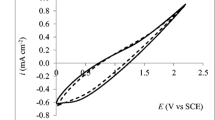Abstract.
The electrochemical oxidation of dilute aqueous solutions of pentachlorophenol (PCP) using Ti/SnO2 as an electrocatalytic material has been investigated. The studies were carried out in a two-compartment electrochemical cell at three different current density values (10, 30 and 50 mA cm–2) at 25 °C and using 20 mg L–1 of PCP in 0.1 M NaOH (pH 10) as supporting electrolyte. The PCP concentration and the by-products of the oxidized solution were monitored during the oxidation process using UV and HPLC techniques. For the three current densities investigated it was found that the rate of PCP elimination depends only on the specific electrical charge. Likewise, the oxidation mechanism was proved to occur through the participation of adsorbed hydroxyl radicals (·OH) formed on the SnO2 surface, whatever the current density used. However, as the applied current density was increased, a current efficiency lower than 2% was obtained, which is due to mass transfer limitations. In addition, it was observed that the PCP was mineralized to CO2 with conversion percentages as high as 92% and at current density values as low as 10 mA cm–2. The PCP degradation produces two other by-products of oxidation (<10%), namely carboxylic acids, which are non-toxic compounds.
Similar content being viewed by others
Author information
Authors and Affiliations
Additional information
Electronic Publication
Rights and permissions
About this article
Cite this article
Quiroz, M., Reyna, S. & Sánchez, J. Anodic oxidation of pentachlorophenol at Ti/SnO2 electrodes. J Solid State Electrochem 7, 277–282 (2003). https://doi.org/10.1007/s10008-002-0340-1
Received:
Accepted:
Issue Date:
DOI: https://doi.org/10.1007/s10008-002-0340-1




